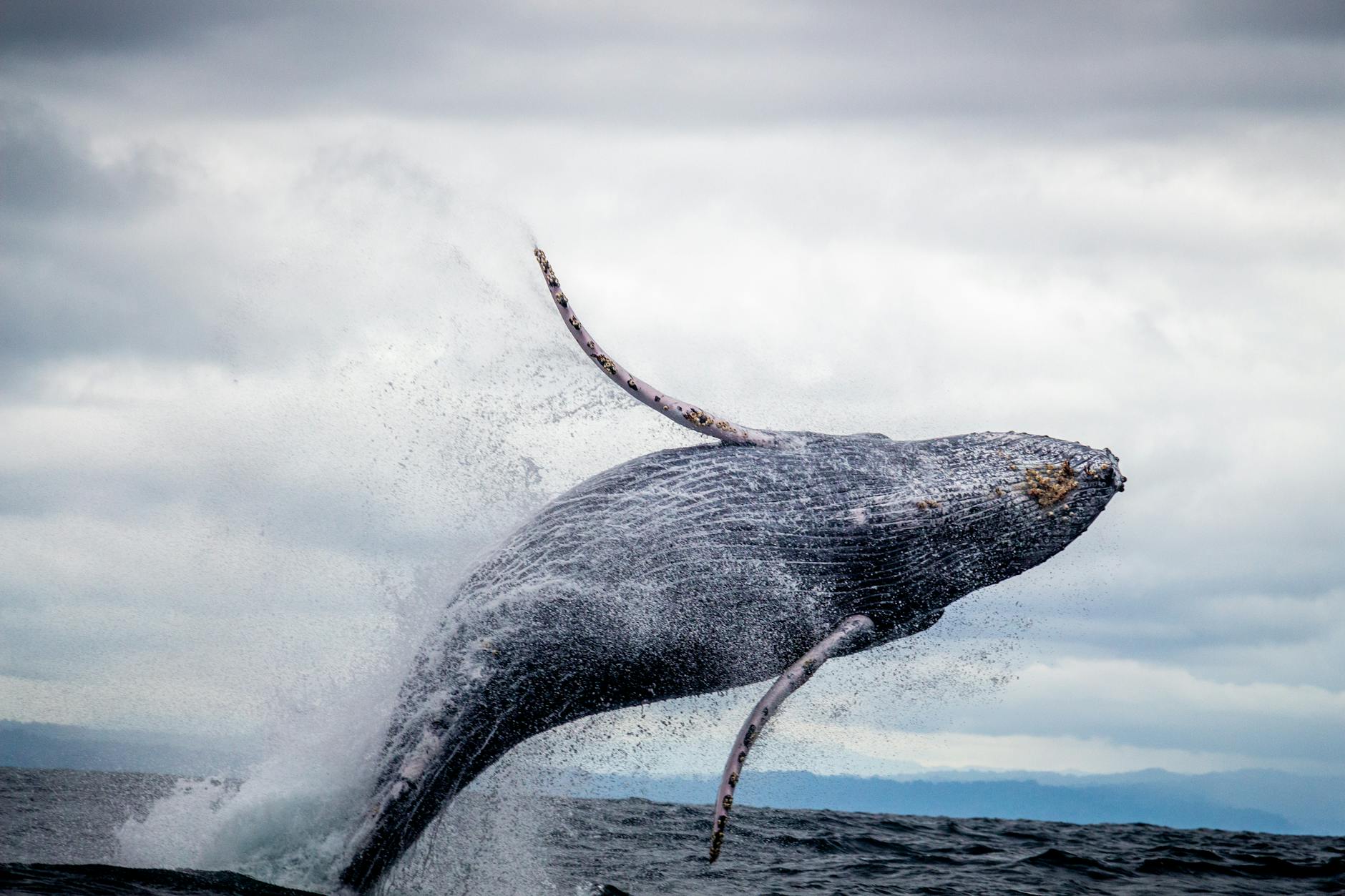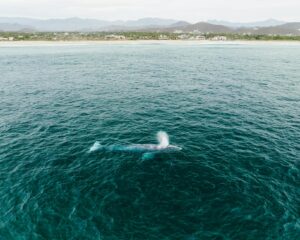The humpback whale (Megaptera novaeangliae) is a found worldwide in tropical, temperate and subpolar waters. It can commonly be seen feeding in shallow waters along the southern coast of Alaska.
In the North Pacific, humpback whales migrate from winter breeding grounds near Japan. Hawaii or Mexico to summer feeding grounds from Washington to as far north as the Chukchi Sea.
Introduction
The humpback whale, Megaptera novaeangliae is a medium-sized baleen whale of the Balaenopteridae family. Which includes all the rorquals and is found in all oceans of the world. At maturity, the humpback reaches a length of about 15.6 m (51 feet) and weighs about 34 metric tons (t).
The body is relatively short and rotund and is characterized by exceptionally long flippers. The flippers, which are one-fourth to one-third the total body length, are knobbed on the anterior edges. The span of its symmetrical flukes is one-third the total body length.
Although generally recognized by a pear-shaped blow about 1.8 m (6 feet) high. It is most specifically identified as it breaches, displaying its unique body contours.
The whale may leap clear of the water and spin partially as it falls with a resounding smack. Sometimes it rolls on the surface, slapping the water with its flukes or flippers. It holds one flipper in the air while lying on one side or both. The humpback has a rich, varied vocabulary and a wide range through the tonal scale.

Its “song,” a long series of varied phrases repeated in sequence over intervals of more than a half hour, is varied from year to year. More it may be identified in a group over some years. Different stocks of whales have regional “dialects. “
General description: Humpback Whales
The humpback whale is a baleen whale, and one of the largest members of the rorqual family. Adult females average 49 ft (15m) in length and weigh approximately 35 tons, with adult males being slightly smaller.
Rorquals can be distinguished by having both a dorsal fin and ventral pleats running from the tip of the lower jaw back to the belly area. The humpback whale has a distinctive robust body shape that narrows to a slender peduncle.
The head is broad and rounded when viewed from above, but slender in profile. The top of the head and the lower jaw contain a series of rounded fleshy knobs. Humpbacks are predominantly black, but have varying degrees of white on the throat, belly, flippers and flukes.
Humpbacks can be distinguished from other whales by the extremely long flippers with large knobs on the leading edge. The flippers can reach 25 to 30 percent of the total length of the animal. The flukes are broad with sharp points and serrated edges.
The shape and pattern of each whale’s dorsal fin and flukes are distinct and have been used by biologists to identify and track individual animals.
Food Habits:
The diet of humpbacks in the Northern Hemisphere consists of both benthic and pelagic-layer organisms of the coastal zone.
These include krill (euphausiids), copepods and other crustacean zooplankton. Moreover, herring, Clupeidae; sand lance, Ammodytes sp. capelin, Mallotus villosus; juvenile salmonids, Oncorhynchus spp.
Arctic cod, Boreogadus saida; walleye pollock, Theragra chalcogramma. pollock, Pollachius virens; and pteropod and some cephalopod mollusks. In the Antarctic the diet is restricted almost only to krill (Nemoto, 1959; Gaskin, 1972)
Baleen whales take their name from the fringed plates called baleen which hang downward on either side of the upper jaw. Humpback whales have a series of 270-400 baleen plates that are dark in color and measure about 30 in (76cm) long.
During feeding, large volumes of water and food can be taken into the mouth. Because the pleated grooves in their throat allow for a large amount of expansion.
As the mouth closes, water is forced through the baleen plates, which act as a sieve, trapping the food inside the mouth.
They are also known for use of bubble nets, created by releasing air bubbles while swimming in circles beneath their prey. So, then lunging, open mouthed, to the surface through the center of the concentrated prey.
Humpback whales rarely feed while migrating or during the winters in the tropical waters. Feeding occurs almost only during the summer months and animals live off of fat reserves while breeding.
During feeding, each humpback whale eats up to 1.5 tons of food per day. This consists mainly of euphausiids (krill), and various small schooling fishes.
Life History:
Females reach sexual maturity at 5 years and males at 7 years. Humpbacks are believed to live to be 40-50 years old. Aging of adult whales has proven to be difficult and studies on aging techniques are ongoing.
Females have an 11.5 month gestation period and give birth to a single calf every 1-3 years. Calves nurse for 6-10 months on milk that is 45-60% fat (human milk is 2% fat). At birth, calves average 10-15 ft (3-5m) in length and weigh about 1.5 tons.
Seasonal movements:
The humpback whale is a migratory species, spending its summers in temperate and subpolar waters. But mating and calving in tropical and sub-tropical waters closer to the equator.
Humpbacks may be seen at any time of year in Alaska. But most animals winter in temperate or tropical waters near Mexico, Hawaii, and in the western Pacific near Japan.
An exception to this rule is a population that remains year-round in the Arabian Sea. Migrations of up to 3,000 miles (4,800 km) each way are typical.
In the spring, the animals migrate back to Alaska where food is abundant and tend to concentrate in several areas including Southeast Alaska, Prince William Sound, Kodiak. More it moves the Barren Islands at the mouth of Cook Inlet, and along the Aleutian Islands.
The Chukchi Sea is the northernmost area for humpbacks during their summer feeding. Although, in 2007, humpbacks were seen in the Beaufort Sea east of Barrow. which would suggest a northward expansion of their feeding grounds.
Behavior:
Humpbacks are usually observed alone or in small groups that persist for only a few hours. Groups may stay together a little longer in summer to forage and feed cooperatively. Long-term relationships lasting months or even years, have been observed, but are rare.
Humpbacks are renowned for their various acrobatic displays. One of the more spectacular behaviors is breaching, which researchers believe may be related to courtship or play.
During mate selection, groups of 2-20 males can gather around a single female and exhibit a variety of behaviors to establish dominance.
Breaching, spy-hopping, lob-tailing, tail slapping, flipper-slapping, charging and parrying can be observed, and these displays can last for hours.
Song is also assumed to have an important role in mate selection. As scientists remain unsure whether the song is used between males to establish identity and dominance, between a male and a female as a mating call, or a mixture of the two.
Humpback whale songs are long, complex, and only sung by males. Whales within a distinct population sing the same song; while the songs of whales from other populations are different. A typical song lasts from 10-20 minutes, is repeated for hours at a time, and changes gradually over the years.
Population size:
Throughout its range, the humpback whale has been listed as endangered under the Endangered Species Conservation Act of 1970, and as depleted under the Marine Mammal Protection Act of 1972.
Worldwide, humpback numbers were severely reduced during commercial whaling. Some evidence suggests 90-95% of the population was removed.
There are 3 separate populations of humpbacks. Those living in the North Pacific Ocean, those in the North Atlantic Ocean, and those roving the oceans of the Southern Hemisphere.
In the North Pacific, more than 23,000 animals were taken in the before this species was granted protection from whaling in 1966. Before whaling began, approximately 15,000 humpbacks are estimated to have existed in the north Pacific.
Current population estimates for the North Pacific stock range from 6,000-8,000 individual animals. An increase in numbers on the Hawaiian wintering grounds suggests. That at least this part of the North Pacific stock is growing by approximately 7 percent per year.
Predators, hunting, and other mortality:
The primary source of mortality for humpback whales is most likely humans.
Historically, most whales were killed through commercial whaling. Currently, whaling is strictly regulated by the International Whaling Commission. With only small numbers being allowed to be taken for aboriginal subsistence purposes.
Two animals per year are allowed to be harvested from the North Pacific stock. Since commercial whaling was banned. Most human caused humpback deaths are through entanglement in fishing gear, boat strikes, or acute exposure to pollutants.
Secondary effects of humans on humpback whales such as pollutants, contaminants, decrease in prey species. Moreover, decrease or alteration in habitat are difficult to estimate.
Killer whales, false killer whales, and large sharks predate upon humpback whale calves. Although it is believed to be relatively infrequent.
Reproduction
Both male and female humpbacks begin to mature sexually at about 9 years of age. Moreover, others placed sexual maturity at only 5 years. but their determinations erroneously assumed the laying down of two laminae per year in the ear plug, instead of only one . Births occur between January and March in the Northern Hemisphere. Gestation lasts about 12 months, and lactation close to a year.
Why protect this species?
Humpback whales, like so many other whales species, were hunted for centuries for their oil and meat. Although hunting in the North Atlantic ended in 1956, in wasn’t until 1966. The International Whaling Commission agreed to globally ban the hunting of humpbacks.
Despite being safe from commercial whaling, humpback whales continue to face threats and disturbances from entanglement in marine debris and fishing gear, boat strikes.
Finally, Potential threats to humpback whales in Canadian waters today include a reduction in their prey base. That incidental mortality in fisheries, ship strikes. Disturbance or injury in association with vessel traffic and or high-intensity underwater sounds. Though none of these threats are thought to currently jeopardize the growth of either population.



